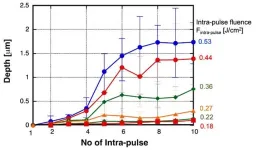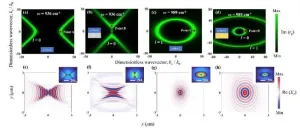(Press-News.org) Scientists at the University of Florida have identified a novel compound aimed at improving the treatment of opioid overdoses, which claimed the lives of more than 81,000 Americans last year.
The discovery could combat the devastating epidemic of opioid-related deaths, driven predominantly by the proliferation of fentanyl. The highly potent synthetic opioid is a pain reliever and among the nation’s most abused substances.
“Fentanyl is driving the need to find better treatments for opioid overdoses,” said Jay McLaughlin, Ph.D., a professor of pharmacodynamics in the UF College of Pharmacy. “Every opioid death is preventable, highlighting the immediate need to improve the treatment options.”
In a study published in the journal Nature, a team of researchers from six laboratories at Washington University School of Medicine in St. Louis, Stanford University, and UF report how they identified and tested the compound 368. When paired with the drug naloxone, compound 368 increased the medication’s ability to reverse the lethal effects of opioid overdose.
Naloxone, also known by its brand name Narcan, blocks the effects of opioids and can temporarily reverse an opioid overdose. The drug acts as an antagonist — binding to opioid receptor sites on nerve cells, thereby preventing fentanyl and other opioids from activating them.
Narcan can quickly restore normal breathing in an individual whose respiration has slowed or stopped because of an opioid overdose.
“We have known for a long time that Narcan can save lives,” McLaughlin said. “However, Narcan is short-acting and tends to wear off quickly. If an individual takes a massive dose of fentanyl, then they will go back into respiratory distress when the Narcan wears off.”
According to McLaughlin, Narcan also triggers withdrawal symptoms in patients dependent on opioids. The research team identified that when compound 368 is combined with low doses of Narcan, it can reverse respiratory depression without inducing withdrawal symptoms.
Narcan and the compound 368 were found to bind at different sites of the opioid receptor, enabling them to complement each other in blocking opioids like fentanyl. This dual binding keeps Narcan attached to the receptor longer, providing extended protection at lower doses of the antagonist against the harmful effects of fentanyl.
“Determining the optimal Narcan dosage has been a persistent challenge for health care providers,” McLaughlin said. “In time, combining a smaller amount of Narcan with our compound may circumvent the danger of patients undergoing opioid withdrawal.”
The latest study builds on new insights into the structure and function of opioid receptors, advancing research published by the same team in November 2022. They previously reported in Nature how modifications to fentanyl’s chemical structure maintained its pain-relieving properties while reducing harmful side effects.
END
Novel compound offers improved defense against fentanyl overdoses
2024-07-08
ELSE PRESS RELEASES FROM THIS DATE:
NIH awards Wake Forest University School of Medicine $27 million to study vascular health and its impact on cognition
2024-07-08
WINSTON-SALEM, N.C. – July 8, 2024 – Researchers at Wake Forest University School of Medicine have been awarded a five-year, $27 million grant from the National Institute on Aging (NIA), part of the National Institutes of Health (NIH), to renew funding for MESA-MIND, an ancillary study to the Multi-Ethnic Study of Atherosclerosis (MESA).
In 2018, researchers at Wake Forest University School of Medicine received more than $18 million from the NIA to launch MESA-MIND to study the connections between heart health and brain health.
“In MESA-MIND, we are studying how heart health contributes to brain health in diverse groups of people,” said Timothy Hughes, Ph.D., ...
College of Public Health receives NIH grant to pilot AI chatbot for African Americans with depression
2024-07-08
As a leader in innovative health solutions, George Mason University’s College of Public Health received a National Institutes of Health (NIH) AIM-AHEAD program grant to pilot an artificial intelligence (AI) chatbot for Black and African Americans with depression. Health Informatics Professor Farrokh Alemi will enhance his first-of-its-kind, evidence-based artificial intelligence tool to address the medication needs of African Americans with depression.
The existing AI tool recommends antidepressants for 16,775 general-population patient subgroups, each representing a unique combination of medical history. For each of ...
RCMAR Annual Meeting promotes mentorship and research on aging
2024-07-08
The latest Annual Meeting convened by the Resource Centers for Minority Aging Research (RCMAR) National Coordinating Center, held in Arlington, Virginia, from June 26 to 28, centered on the theme of transforming diverse aging research through inspiring and mentoring scientists.
Current and former RCMAR scientists presented research findings from completed pilot studies and progress updates for ongoing research. The meeting included several professional development sessions for the scientists and members of RCMAR ...
Exploring distress experiences of patients with sickle cell disease
2024-07-08
COLUMBUS, Ohio – While distress is well-documented in patients with sickle cell disease, sources of distress and how patients manage distress have not been well explored.
“Our study found that the most profound source of distress for patient with sickle cell disease in a home visit program was anticipating and going to acute care centers to manage their acute pain,” said senior study author Maryanna Klatt, PhD, director of the Center for Integrative Health at The Ohio State University Wexner Medical Center.
Study findings are published ...
Super-resolution machining of single crystalline sapphire by GHz burst mode femtosecond laser-induced plasma assisted ablation
2024-07-08
A new publication from Opto-Electronic Advances; DOI 10.29026/oea.2024.240029 , discusses super-resolution machining of single crystalline sapphire by GHz burst mode femtosecond laser-induced plasma assisted ablation.
GHz burst-mode femtosecond (fs) laser, which emits a series of pulse trains (burst pulse) with extremely short intervals of several hundred ps, offers distinct characteristics in materials processing as compared with conventional fs laser (single-pulse mode). The authors of this article have demonstrated that the GHz burst mode fs laser greatly improves ablation efficiency, quality and speed. GHz burst mode fs laser was further applied ...
Boosting UV light absorption in 2D semiconductor with quantum dot hybrids for enhanced light emission
2024-07-08
A new publication from Opto-Electronic Advances; DOI 10.29026/oes.2024.240002 , discusses boosting UV Light Absorption in 2D Semiconductor with quantum dot hybrids for enhanced light emission.
Two-dimensional (2D) transition metal dichalcogenides (TMDs) have emerged as a promising class of materials due to their remarkable properties. These materials, such as monolayer tungsten disulfide (1L-WS2), are just a few atoms thick, yet they possess intriguing electronic and optical characteristics that make them highly attractive for various applications, from flexible electronics ...
The forbidden propagation of hyperbolic phonon polaritons and applications in near-field energy transport
2024-07-08
A new publication from Opto-Electronic Advances; DOI 10.29026/oes.2024.230053 , discusses forbidden propagation of hyperbolic phonon polaritons and applications in near-field energy transport.
Manipulating photons on the nanoscale to develop integrated and miniaturized optoelectronic devices as well as photonic chips has been a strong pursuit of the nanophotonics community. Among them, phonon polaritons supported by two-dimensional layered van der Waals (vdW) materials, which have emerged in recent years, have attracted much attention by virtue of their ultra-long lifetimes, ultr-low losses, and strong confinement capabilities, ...
Researchers find common immune system mechanism between pregnancy, cancer
2024-07-08
For more information, contact:
Nicole Fawcett, nfawcett@umich.edu
734-764-2220
For immediate release
ANN ARBOR, Michigan — To understand why some cancers successfully circumvent the immune system to grow unchecked, researchers turned to pregnancy.
“In pregnancy, the immune system does not reject the growing fetus, so we know there must be mechanisms active in the placenta. In cancer, it’s the same thing: the growing tumor is not rejected by the immune system. It means the cancer cells have developed strategies to suppress immune rejection, same as in pregnancy,” said Weiping ...
UC San Diego health offers novel gene therapy for bladder cancer
2024-07-08
UC San Diego Health is the first health system in San Diego County to offer a new bladder-saving gene therapy to treat localized bladder cancer.
The novel treatment is the first and only FDA-approved gene therapy delivered directly into the bladder for non-muscle-invasive bladder cancer (NMIBC). Called nadofaragene firadenovec (Adstiladrin), the gene therapy addresses an unmet need for patients who are no longer responding to the longstanding first line of defense — bacillus calmette-guerin (BCG), a bacteria-based immunotherapy for cancer management. While BCG is a common first therapy, it can eventually stop working, ultimately leading to complete bladder removal.
The American ...
SETI Institute awards its first research and education innovation grants
2024-07-08
July 8, 2024, Mountain View, CA – Today, the SETI Institute announced the first projects it will fund with a new program to Support Technology, Research, Innovation, Development, and Education programs – or STRIDE. The SETI Institute established the $500K STRIDE fund for SETI Institute researchers and EOC (Education, Outreach, and Communications) professionals to develop innovative research and education proposals. The first five grants awarded will support projects that:
analyze Earth’s colors and climate to create detectors for studying exoplanets
develop a multi-backend capability for ...





